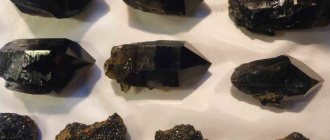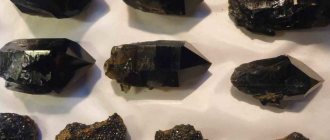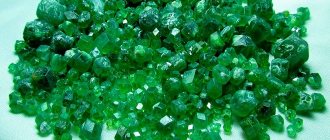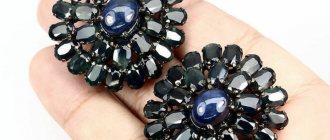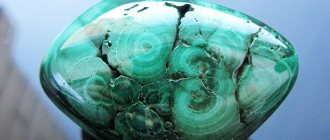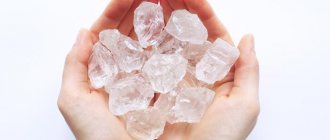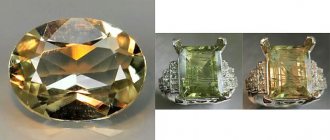Classification of precious stones. Varieties of precious stones by color. How to identify a real stone among the many fakes, imitations and hacks?
Today, jewelry specialists have a much more difficult time than their predecessors. If a few decades ago a genuine gemstone could be easily distinguished from a fake, even visually, then in the world of modern technology and progress it is almost impossible to do this by eye.
In addition to the well-known hacks made of glass, imitators of expensive stones from cheaper minerals, a new product has appeared on the jewelry market today - stone grown in laboratory conditions. Such a creation of human hands visually looks no worse than a mineral created by nature over many decades, but it costs several times less. How to distinguish a genuine natural stone from a fake or artificial stone? What precious minerals even exist?
Black gems: name, description, photo
Black gemstones
There are so many minerals in nature that stand out for their black color. Some of them are so rare that it is almost impossible to find any information about them. In many cases, the name “black” stone can be considered relative, since in fact the mineral has a lighter or non-uniform color. Here are the most common black stones in jewelry:
Gems
Black diamond or carbonado
Black Diamond is the greatest rarity and value in jewelry. However, it is worth noting that it never reaches the level of jewelry, since its cutting and processing is very complex - it can only be done using the same stone. In the annals of jewelry there are only a handful of such stones, the most expensive of which was estimated at 1.7 million dollars. The other two became known as "Black Star of Africa" and "Korloff Noir".
Black Diamond
Black sapphire
True black sapphire does not exist in nature. Almost all black sapphires are the work of scientists. They are obtained by processing blue sapphires. The few black sapphires that are of natural origin can hardly be called black, since their color is closer to the color of the sky at night. The most famous black sapphire is the Black Star of Queensland, worth $100 million.
Black sapphire
Black Pearl
This type of pearl is also difficult to consider truly black, since its darkness is softened by the mother of pearl of the pearl. However, the cost of such a curiosity remains quite high to this day. The rarest specimens of black pearls are collected in Tahiti in the corresponding museum.
Black Pearl
Black opal
This type of opal is considered one of the most expensive and valuable rocks. Most often, this mineral is found in deposits located in the least developed countries of the world, which causes numerous human losses during its extraction.
Black opal
Black spinel
Black spinel is one of the most inexpensive types of black gemstones. Its cheapness is easily explained by the fragility of the stone and the complexity of its processing. Most often, spinel is used in needlework or jewelry in the form of cabochons.
Black spinel
Semiprecious stones
Black quartz or morion is the only representative of semi-precious stones of black color. This mineral is most often used in jewelry today. Externally, it has an opaque or barely transparent surface.
Black quartz or morion
Jewelry and ornamental stones
Black agate
In fact, black agate does not exist in nature. Only dark coal-colored minerals can be found. A rich black color can only be achieved through technological processing of this stone.
Black agate
Other representatives of black jewelry and ornamental stones are: black onyx, obsidian, black jasper or jet, hematite, argillite and hypersthene.
What types of stones are there?
According to the classification of natural crystals developed by A. E. Fersman, depending on their rarity, features and value, 3 groups of stones for jewelry can be distinguished: precious (or semi-precious), semi-precious and ornamental.
Gems
Precious stones are rare minerals with a beautiful appearance, which rightfully include noble diamond , spring emerald , fire ruby , topaz , sapphire , zircon .
Precious stones are also divided according to classification, for example, there are 1st order, like diamond , 2nd, like topaz and 3rd, like zircon . Depending on this order, they have different prices. However, it may depend on the size and characteristics of the gems.
It happens that a stone of a lower order can cost more than a mineral of a higher level. Basically, all emeralds that are used by master jewelers are up to 2 carats, and the cost can range from $500 to $1000. However, an emerald weighing more than 3 carats sometimes exceeds the price of even a ruby and a diamond of that weight. You can always ask a jeweler what stones I make jewelry from.
Semiprecious stones
This group includes crystals that are not as rare as precious ones. There are much more deposits of them on Earth, so they are considered semi-precious. This category includes amethyst , garnet , agate , tourmaline , peridot and many others. The cost of these minerals, of course, is much lower than precious ones. However, there are exceptions here too.
For example, high-quality tourmaline costs from $25 to $150 per carat. However, sometimes you come across stones that combine a smooth transition of 2-3 colors, the cost of which is approximately $1000 per carat. The blue-green mineral is much more expensive - up to $5,000. You can check with the master what kind of stones the jewelry you like is made from. Often these characteristics are indicated on the jewelry tag.
Ornamental stones
Ornamental materials mainly include opaque minerals, rock or organic compounds. Such stones do not have a bright shine, but with a good cut they can even be compared with precious crystals. In ornamental jewelry you can find: jade , lapis lazuli , sodalite , azurite , malachite , jasper , vesuvian , etc. Check in the store or with the master what stones are used to make the jewelry you have your eye on.
White gemstones: name, description, photo
White gemstones
White or naturally transparent minerals are considered the most expensive and valuable stones in jewelry. White gemstones include:
Diamond or diamond
It is a transparent diamond or an already cut part of it (diamond) that first comes to the mind of any person (especially women) when mentioning white precious stones. Indeed, this mineral is considered one of the most sought after. Its high cost is easily explained by the few deposits of this mineral in the ground. At the same time, only a small fraction of all mined diamonds are suitable for cutting.
Diamond
Transparent spinel
Unlike its black counterpart, white spinel is a fairly expensive stone with a high strength. The impeccable purity and the fact that this mineral contains no impurities makes it even more valuable. White spinel is most often used in luxury jewelry.
White spinel
Colorless topaz
With the naked eye, this mineral can easily be confused with a diamond. However, upon closer inspection, differences can be detected. In jewelry, it is customary to frame colorless topaz in noble white metals - gold, platinum.
White Topaz
Goshenite or colorless beryl
Goshenite is also very similar in appearance to diamond, but its shine can rather be called more chilling and restrained.
Goshenite
Pearl
White pearls have always managed to captivate the fair sex with their warmth and tenderness. Oddly enough, in nature, pearls rarely have a round shape (such representatives are highly valued) - more often they are oblong and uneven. Pearls also have one more feature - their lifespan. If ordinary minerals will delight the eye with their beauty forever, then a pearl can “go out” at any moment. The lifespan of this mineral does not exceed 300 years.
White pearls
Achroite or white tourmaline
This type of rock is very rare, since its deposits are located in only one point on the map. Achroite is quite rare in the form of jewelry. This kind of pleasure can only be ordered from a few jewelry workshops in the world.
White tourmaline or achroite
Semi-precious white stones include white agate, rock crystal and white opal.
Jewelry and ornamental stones can boast of the presence in their list of such white minerals as milky coral, white jasper, moonstone, and white-green jade.
Stones of female names
Stones of female names In European culture, a certain correspondence between common female names and precious stones has long been developed. No matter how you look at this connection, it helps to make a choice of one or another piece of jewelry with a gem. Alexandra (ancient Greek protector of people) Lively, restless and tireless. Always near. Usually the character is similar to that of a man. Life path: “tomboy” - “business woman”. She is so active in society and family that, alas, she does not always have enough strength for tenderness. Stones: garnet, which helps awaken passion and tenderness, malachite, which fulfills wishes, chrysolite, which warns against unreasonable actions. Alice (noble class - Old English) has an easy-going and pragmatic character, is clean and thrifty. Those born in winter are persistent to the point of stubbornness, principled, but fair. “Summer” is softer, more sentimental, and unenvious. Stones: alexandrite, warning of danger, lapis lazuli, helping to implement plans and projects, topaz, attracting material wealth. Alevtina (rubbed with incense, averse to evil - other Greek) Categorical in her judgments, intolerant of the opinions of others. Surrounds himself with many friends, but doesn't trust any of them. She is difficult to please, she is dissatisfied with everything. He values himself extremely highly, so he chooses a lifelong friend for a very long time. Stones: serpentine, helping to avoid dangers on the path of life, protecting from bad influences, jade, helping to get out of everyday dead ends. Alla (other, second, next - ancient Greek; this goddess is from the ancient Arabic goddess Allat) The name “Alla” in terms of strength and intensity of sound can be compared with the brightness, saturation of scarlet color (listen: Alla - scarlet). Alla has a strong character, she knows her worth, and is sometimes arrogant. Demanding of others. Energetic, purposeful, in good health, she confidently moves through life. At the same time, Alla is easily vulnerable and often feels a lack of human warmth and participation. Stones: agate, as a symbol of health, prosperity and longevity, olivine, pacifying anger. Anastasia (resurrected - Greek) Usually her nature is complex and contradictory. Proud, strict and persistent. Crafty and attractive. Changeable and elusive. Stones: fluorite, which helps to organize thoughts and achieve a state of mental peace, chrysoprase, which protects from the evil eye and damage, envious people and slanderers, zircon, which instills in a person self-confidence, optimism and good spirits. Angela (derived from Angelica: angelic - lat.) Angela is usually an attractive and charming woman. Only she herself does not rely on beauty and does not strive to emphasize it. She holds other values in high esteem: intelligence, knowledge, success in the professional sphere. This is a strong personality who knows how to achieve her own goals. Stones: lapis lazuli, which helps to implement plans and projects, opal, as a symbol of happiness, hope and love, citrine, as a stone of wisdom and tranquility. Anna (merciful - ancient Hebrew) Truth-loving, uncompromising. Restrained and passionate, “breakdowns” are rare. Conscientious, kind and affectionate. Stones: amber, which gives the owner physical strength, good spirits, brings good luck and preserves health. Antonina (extensive - lat.) Responsive, trusting. He knows how to support in word and deed, with money. Lyrical. Stones: agate, as a symbol of health, prosperity and longevity, smoky quartz, protecting against the evil eye and damage, phenacite, as a stone of spirituality. Bella (beautiful - lat.) She is principled and reasonable, although sometimes she acts impulsively. She is talkative and sociable, quickly makes new acquaintances, sensitive and emotional. Stones: cacholong, which brings peace and tranquility to the house, cat's eye, which protects from evil forces, the evil eye, topaz, which attracts material wealth. Bronislava (glorious protector - slav.) Kind, obliging and honest, hospitable, a skillful housewife, a devoted wife and a good mother. Does not tolerate deception. Bronislava is distinguished by her demandingness towards herself and others. By profession, these women are most often teachers, engineers, music teachers, salespeople, and accountants. Stones: opal, as a symbol of happiness, hope and love. Valentina (strong - lat.) Frank, spontaneous, faithful, friendly. Not so much beautiful as cute. Sensual. Dreams of eternal love. In public life - always in search of something new. Stones: Amazonite, which helps strengthen family relationships, olivine, which pacifies anger, carnelian, which protects against human ill will, the machinations of enemies and evil spells. Varvara (cruel - lat.) Majestic, self-possessed, however, has difficulty maintaining emotional balance. She is quarrelsome and often disagrees with the majority. He chooses his betrothed meticulously. Long-lived. Stones: jet, which absorbs negative energy. Vasilisa, Vasilina (royal - Greek) Difficult to comprehend, adamant, guiding. Bringer of fate, generously bestowing. Unstable in behavior. Her actions are often incomprehensible to others. Circumstances favor it, but this should not be abused. Stones: turquoise, as a stone of brave people capable of leading the fight against evil, onyx, as a stone of self-confident people, rhodonite, awakening hidden talents and abilities. Vera (Old Russian) Smart, diligent, values order, truthful. Reaches for the sublime. Stones: aquamarine, strengthening spirituality and imparting prudence, ruby, protecting from dangers. Veronica (bringer of victory - ancient Greek) Sociable, sparkling, but stubborn and irritable. Stones: rose quartz, helping to fight stress, extinguishing outbursts of anger, sapphire, calming, taming passions. Victoria (winner - lat.) Temperamental. Usually stubborn. It's lazy to work with, but it has extraordinary taste. Athletic, photogenic. Loves to be the center of attention. Allows himself extravagance. Stones: Variscite, which helps to find balance between body and spirit, supporting emotional stability. Vita, Vitalia (vital - lat.) Brave, decisive and at the same time charming, soft in communication. Vitalia is proud and knows what she wants from life. She strives to be different from those around her, but is always looking for an ideal to follow. Stones: rhodonite, awakening hidden talents and abilities, tiger's eye, protecting from dangers. Darina (on behalf of the Persian king Darius; winner who owns wealth - Old Persian) Knows her worth, is demanding and capricious, jealous, capable of getting angry over trifles. Stones: chrysoberyl, which brings peace of mind and healing, protects from all kinds of everyday troubles. Daria (great fire - pers.) With a choleric temperament, with strong, quickly arising feelings, but not rash. You can go far in work and creativity. Arouses interest. Artistic. And yet - a homebody. Stones: diamond, which drives away fears and protects from negative influences; obsidian, which protects against wrong actions. Evgenia (noble - Greek) Confident in her abilities, demanding, fair, always ready to come to the aid of someone in trouble. Stones: aventurine, which helps to gain courage and clarity of mind, increasing optimism and confidence; rubellite, which has a beneficial effect on the heart. Evdokia, Avdotya (benevolence - Greek) Kind and flexible, non-conflict, sociable, neat and prudent. They don't do anything thoughtlessly. She has golden hands, any work goes smoothly. Stones: Moonstone, which perceives and attracts love. Catherine (true hope, eternally pure - Greek) Decisive, talented, thrifty and at the same time generous. Always in a good mood, calm and friendly. Stones: beryl, which helps maintain good spirits and protects against fatigue; tiger's eye, protecting from dangers. Elena (solar - Greek) Exciting, spiritualizing, attracting, bewitching, fabulous, creating joy. With great inner charm. With a personal view of the world. Stones: onyx, like the stone of self-confident people. Elizabeth (who worships God - Hebrew) Devoted, indulgent. Subject to stress, although she holds up well. Relies on intuition and is often deceived. Delicate and feminine, sentimental. Stones: olivine, restraining rash impulses. Jeanne (French version of the name John: Grace of God - Old Hebrew) Stubborn, authoritarian, purposeful. Stones: rock crystal, sharpening thought processes; carnelian, which protects against human ill will, the machinations of enemies and evil spells. Zinaida (divine - Greek) Original, with a constant desire for primacy, with character. With extraordinary and refined taste. Stones: emerald, as a stone of wisdom, composure and hope. Zoya (life - Greek) In character there is an amazing combination of extremes: hardness and softness, coldness and tenderness. Stones: jadeite, which gives an emotional charge; cat's eye, which helps to establish relationships with people. Inna (stormy stream - Greek) Intellectual, easily vulnerable. It's not easy with her. Capable of unexpected actions. Generous for good deeds. Stones: diamond, which drives away fears and protects from negative influences; pearls that soothe the psyche, bringing peace of mind and peace; emerald as a stone of wisdom, composure and hope; mother of pearl, stimulating and strengthening the body. Irina (peace - Greek) Loving, caring mother, faithful wife. Patient to the point of sacrifice. Never, even with age, loses its attractiveness. Stones: belomorite, protecting from dark forces; pearls that bring peace of mind and peace; coral as a symbol of modesty; mother of pearl, stimulating and strengthening the body; chalcedony, which drives away melancholy and creates a good mood. Karina (from the Latin word meaning the keel of a ship: looking forward.) Determined, active, does not like to be in the shadows. She is smart, able to quickly solve the most complex problem, and knows how to learn as she goes. Sensual and sexy. Stones: Jasper is a stone that helps build relationships. Claudia (from Claudius, lame - lat.) Hardworking, patient, affectionate, caring. Stones: pearls, bringing peace of mind and peace; onyx, which gives confidence in one’s abilities; mother of pearl, stimulating and strengthening the body. Clara (light, clear - lat.) Silent, modest, dresses modestly but tastefully, loved by her friends, a caring wife and mother. Stones: chrysoprase, as a talisman against envious people and slanderers. Larisa (seagull - Greek) Freedom-loving, expressive, attractive. Highly impressionable. Demanding, scrupulous. Stones: Turquoise, as a stone of brave people capable of leading the fight against evil. Lydia (from Lydia - a region in Asia Minor - Greek) The character is complex, secretive. Has a masculine mentality. Brave and strong in spirit. Independent, truthful. Stones: jet, absorbing negative energy; Malachite, which fulfills wishes. Lina (in many eastern languages means “tender”) The character fully corresponds to the meaning of the name. She is very amorous, which is why she often suffers. Stones: jade, helping to get out of everyday dead ends. Love (Old Russian) A little frivolous, vulnerable, in need of affection. Complaisant, compliant. In her hands everything goes wrong. Good, but not always lucky in life. Internally stable, pious Stones: dioptase, promoting the rise of vitality; rose quartz, which helps fight stress; chalcedony, which drives away melancholy and creates a good mood. Lyudmila (dear to people - glory.) Caring, condescending. She knows how to correctly assess her capabilities, is slightly crafty, and jealous. The desire to be liked sometimes harms her. Stones: alexandrite, warning of danger; pomegranate, which helps awaken passion and tenderness. Margarita (pearl - Greek) Dreamy and tender, honest and selfless, compassionate. He values his independence very much. Mysterious. Stones: ruby; tiger's eye, protecting from dangers. Marina (sea - lat.) Darling of fate. Impatient and impulsive, does not know what she will do in a moment. Stones: amethyst, as a stone of sincerity and sincerity; turquoise, giving courage; chrysoprase as a talisman against envious people and slanderers; jasper, which helps improve relationships. Mary (bitter, superiority - ancient Hebrew) Fair, benevolent in judgment. Ready to stand up for society. Knows how to endure. Stones: garnet, which helps awaken passion and tenderness; sapphire as a symbol of wisdom and justice; carnelian, which protects against human ill will, the machinations of enemies and evil spells. Nadezhda (Old Russian) Hardworking, inventive to the point of adventurism. It can be tough and demanding. Does not accept effeminacy and cowardice. True to her word, reliable. Stones: agate, as a symbol of health, prosperity and longevity; coral as a symbol of modesty. Natalya (natural, native - lat.) Feminine and soft, lyrical and shy, passionate and indulgent. She is outwardly frivolous, but in difficult situations she is independent. Dreamer. Stones: beryl, which helps maintain good spirits and protects against fatigue; obsidian, which protects against wrong actions. Nina (from Nin - the capital of Assyria - cargo.) She is self-sufficient, values herself, and this helps out in complicated circumstances. Stones: amber, which gives the owner physical strength, good spirits, brings good luck and preserves health. Nonna (nanny, nurse - lat., according to another version - dedicated to God - ancient Egyptian) has a gentle disposition, is fair and kind, does not tolerate lies. Stones: sodalite, which promotes inner harmony. Oksana (derived from Ksenia: - wanderer - Ukrainian) has a persistent character, is firm, dignified, fiery and eccentric, hospitable. Stones: aventurine, which helps to gain courage and clarity of mind, increasing optimism and confidence; citrine, which promotes mutual understanding and helps establish psychological contacts. Olga (light - Scandinavian) Independent, stubborn, dangerous in anger, devoted. Stones: opal, as a symbol of happiness, hope and love. Raisa (light - Greek). Smooth in communication with loved ones. Assiduous, practical, scrupulous. No complexes. Stones: hematite, which helps maintain optimism, courage and will; phenacite, promoting self-knowledge. Svetlana (light - glorified). She's neat, but she's rarely organized in life. Stones: coral, as a symbol of modesty; malachite, which fulfills wishes; Rhodonite, awakening hidden talents and abilities. Sophia (wisdom - Greek) Knowledgeable, righteous, sensible. Mother of Faith, Hope, Love - traditions are passed on through them. Stones: tourmaline, which helps to concentrate attention and gives clarity to the mind; spinel, which feeds people with vitality. Taisiya (goddess of fertility - ancient Egypt) A brilliant, seductive woman. Stones: jade, helping to get out of everyday dead ends; topaz, attracting material wealth. Tamara (date palm - ancient Hebrew) Proud, self-confident. Always up to date. Stones: lapis lazuli, helping to implement plans and projects; fluorite, which helps to organize thoughts and achieve a state of mental peace. Tatyana (lady - Greek) Loyalty combined with self-esteem are traits of Tatyana’s character. Does not accept deceit and evil. Stones: jet, absorbing negative energy; obsidian, which protects against wrong actions; Jasper is like a stone that helps build relationships. Julia (from Mulia: wavy, fluffy - Greek). Movable, noticeable, talented, with a twist. Stones: jadeite, which gives an emotional charge; emerald as a stone of wisdom, composure and hope; rubellite, which has a beneficial effect on the heart. Yana (God has mercy - ancient Hebrew) Attractive, emotional, capricious, capable of looking like both a real fury and a charming, soft, benevolent woman. Stones: Labradorite, developing endurance; Citrine is like a stone of wisdom and tranquility. Yaroslava (brilliant, sunny - glory.) She has inexhaustible optimism and friendliness, she is stubborn, but is able to admit her mistakes. She has innate honesty and truthfulness. Stones: azurite, which carries healing energy; quartz, healing mental and heart wounds.
Blue gems: name, description, photo
Blue gemstones
Blue or cornflower blue sapphire
Only an experienced specialist will be able to distinguish these two types of mineral by eye. Blue sapphire is valued somewhat lower than cornflower blue sapphire, but it is still considered a precious stone. As for the cornflower blue sapphire, in ancient times it was used only for inlaying royal outfits and jewelry.
Blue sapphire
Cornflower blue sapphire
Topaz
Topaz is most often found in blue, but in nature it also comes in other colors - yellow, green, orange, etc. Topaz is not an overly expensive mineral. Most often it is framed in white precious metals - platinum, white gold. Such metals seem to emphasize its gentle radiance.
Blue Topaz
Aquamarine
Already from the very name of the mineral, its origin and associations associated with it become clear. The marine color of this stone helps jewelers create masterpiece blue jewelry. Aquamarine lovers should pay attention to the fact that this mineral is quite fragile - exposure to chemicals, mechanical damage and heat treatment negatively affect its condition.
Aquamarine
Blue spinel
This color of stone is extremely rare, which determines its rather high price. Framed, it can only be found in exclusive creations by jewelers, which are often kept in private collections and cost tens or even hundreds of thousands of dollars.
Blue spinel
Semi-precious blue stones include: zircon, chalcedony. Turquoise, apatite, bezoar, and amazonite are considered ornamental blue stones.
Classification of gemstones
Jewelry stones can have different appearance, color and value, which is why such minerals require strict classification. Modern methods of separating gemstones differ significantly from those proposed a century or two earlier. For example, in the nineteenth century, stones were divided into eastern and western, as well as precious, healing, building and ornamental stones. The classification was based on no cost component, but the price and rarity of a mineral are fundamental factors. Therefore, at the beginning of the twentieth century, mineralogist G. Gurich divided jewelry stones into 5 classes: transparent stones with high light refraction parameters (two classes), semi-precious stones and colored stones (two classes). After Gurich, the table was supplemented and modified, but now it is considered irrelevant.
Currently, gemologists use in most cases the classification of V.I. Sobolevsky.
Precious stones of the first category (gems) 1st class : diamond, alexandrite, emerald, euclase, chrysoberyl, ruby, noble spinel, sapphire. Class 2 : topaz, sparrowite, aquamarine, pink and dark red tourmaline, heliodor, phenacite, zircon, amethyst, noble opal. 3rd class : turquoise, chrysoprase, colorless rock crystal, agates with an original pattern, rauchtopaz, carnelian, amber, bloodstone, jet, etc.
Colored stones of the second category 1st class : malachite, jade, labradorite, rhodonite, chalcedony, lapis lazuli, aventurine, amazonite, written granite, etc. 2nd class : agalmatolite, fluorite, marble onyx, jasper, selenite, meerschaum, etc.
There is a simpler classification of jewelry stones
Top-notch gemstones : diamond, chrysoberyl, sapphire, ruby, emerald, spinel, alexandrite, lal, euclase.
Second-class gemstones are topaz, beryl, aquamarine, demantoid, red tourmaline, blood amethyst, phenacite, opal, almandine, hyacinth, zircon.
Semi-precious stones: garnet, dioptase, epidote, turquoise, light amethyst, sunstone, green tourmaline, transparent rock crystal, rauchtopaz, chalcedony, moonstone.
Gemstones: jade, labradorite, lapis lazuli, rose quartz, jet, bloodstone, amber, amazonite, original spar cabochons, jasper, Vesuveman, coral, mother-of-pearl.
The simplest and most common classification divides jewelry stones into precious, semi-precious and ornamental. Transparency of the structure is typical for precious and semi-precious stones. It is these types of precious stones that are called semi-precious stones. Ornamental stones are mostly opaque or have a barely noticeable tint.
What stones should be classified as precious, semi-precious and ornamental?
Rarely found precious stones in nature include diamond, alexandrite, sapphire, ruby, and emerald. It is recommended to set these stones in gold. Tourmaline, turquoise, topaz, amber, opal, garnet, amethyst, and aquamarine are more common. The above stones are also recommended to be set in gold; Silver is also great for setting semi-precious stones.
The ornamental stones include onyx, malachite, agate, lapis lazuli, jade, etc. They are set in silver or used to make sculptures, vases and other interior items.
Ornamental stones can be classified according to the degree of hardness: Hard ornamental stones Their hardness is 5.5-7 on the Moss scale, and a knife or other cutting tool does not leave even slight roughness on the surface. Hard ornamental stones are chalcedony, jade, jadeite, rhodonite, malachite, jasper, lapis lazuli, amazonite, etc. Medium-hard ornamental stones Their hardness is 3.5-4 on the Moss scale, the surface is easily scratched with a knife or file. Typical representatives of such stones are marble, onyx and porphyry. Soft ornamental stones. Their hardness is 1.5-2.5 on the Moss scale; scratches appear on their surface even from nails. These are selenite, serpentine, gypsum, calcite, talcum stone, etc.
Precious stones, such as diamond, sapphire, ruby or sapphire, are measured in carats, but semi-precious and ornamental stones are usually measured in grams, although for semi-precious stones the weight indicated in carats is quite acceptable.
Stones of all three types described above are widespread in Russia. Thus, the largest deposits of jewelry stones are the Urals, Transbaikalia, Yakutia, and Altai. The weight unit of semi-precious stones, as well as ornamental stones, is gram.
Blue gems: name, description, photo
Sapphire
gemstones
Blue sapphire
Topaz
Blue Topaz
Lapis lazuli
Lapis lazuli is a gemstone that is most often set in yellow gold. This mineral is believed to have strong healing and protective properties.
Lapis lazuli
Semi-precious blue stones include turquoise, the color range of which includes dozens of shades of blue, green and light blue.
Turquoise
Ancient names of precious stones
Sometimes in literature - both fiction and specialized - you can find ancient names for certain natural stones. But it is not always possible to immediately understand what kind of gem we are talking about. Does the name “Turkiz” tell you something? Can you tell what color the “king” is? What are the habits of the “Siberian ground squirrel”? Do you know where the “flint savage” lives? Are “dumplings” and “mountain lard” tasty?
Augustite is the ancient name for high-quality deep blue aquamarine . Agates - now we call this stone a little differently - agate . Adamant is the name the diamond in ancient times. Azurite is a blue lapis lazuli ; its other names were: copper blue, mountain blue, copper azure. Alatyr or latyr is the name given to amber . Almas is a diamond . They learned relatively recently to process a diamond so that it has a play on its edges, that is, to cut it, which probably explains the fact that in ancient times a diamond was not considered an expensive stone: it was not highly valued and was not particularly traded. In the then Wikipedia, or more precisely, in the trade book for Russian merchants of 1575 and 1610, the price of this stone is not indicated at all; it did not even deserve a mention in the chapter “0 all kinds of expensive stones.” In the old days, diamonds were not known in our country, and the first specimens were imported from India. In Western Europe, interest in diamonds appeared somewhat earlier. India usually used natural crystals that retained the octahedron shape, which is how diamonds first came to our country. They were only slightly polished. The French, or rather Louis Berquin, were the first to learn how to cut diamonds: he first introduced a cut diamond, that is, a diamond, in Paris in 1454. Diamonds first appeared in Rus' around 1500. in appearance, at first they were flat “roses”, and fifty or even a hundred years later real diamonds appeared - diamonds with a brilliant cut. Almandine was in ancient times called carbuncle and anthrax ; in the Middle Ages it was known as karfunkelyptein , but today it is called pomegranate , or garnet . The name garnet has been known in our country since the 16th century. Antavent - this stone is mentioned in epics, but it could not be identified. Asp - black marble There is an expression: “work with slate,” that is, made to look like marble (for example, marbled paper).
Babogur - agate. Bakan - this was the name in Russia for ruby spar , orlets , which today is more often called rhodonite . In ancient times, diamonds with a dirty tint were called cormorant diamonds. Balangus - this was the ancient Russian name for ruby . Balas ruby is a natural red spinel . Baus , or bogus - ornamental or semi-precious stones of blue and blue color: kyanite , cordierite , indigolite , sapphirine , etc. There is an assumption that this name - “baus” - is associated with the name of Jeremiah Baus, a famous dealer in jewelry, including natural ones stones, who was also in Moscow under Ivan the Terrible as an envoy of Elizabeth, Queen of England. Belir - most likely, this means beryl . Becheta , or bicheta - from the eastern word “bajadi”; an old Russian name for low-value red stones. In the Russian trade book of the 16th century. it was said: “Bechet means towards the light: there are like bubbles in it.” Most often this meant garnet (almandine).
Varenik is the ancient Russian name for reddish amethyst . In a trade book of the 16th century. it is said about him: “And the dumpling of the nobility: although it is red, another whole place shines white, like any crystal, but the weight of the dumpling is four spools and if only it is as big as yachts, and the color is the same paint as lal, buy 2 stones for 100 rubles or more, and buy one, like a yacht, for the same sample for 50 rubles.” Verillos - belir , beryl . “Tales of the Russian People” says: “Verillos is a very precious stone.”
Mountain lard is a talc , very soft, cloudy white (sometimes slightly transparent).
Diamond is the same as adamant , that is, diamond .
Jade - until the mid-19th century, this was the name given to jade and jadeite . Pearl - Burmite (Burmite) grain - an old Russian name, derived from the corrupted word “Urmite”, or rather “Ormus” grain, i.e. grain from the city of Ormus, located on the Persian Gulf, where pearls were caught and sold in ancient times. There is an assumption that the name Burmite grain comes from the corrupted word “Gurmysh” (Gurmysh, i.e., Apskoe, sea): “even if there is a Gurmysh sea, pearls will be born in it.” There is no doubt that the name Kafim pearls came from the city of Kafa, present-day Feodosia, where, in all likelihood, the Genoese and Greeks caught and sold pearls.
Zaberzat , or zebarzhdat; according to the assumption of some researchers - Indian chrysoberyl of a dense yellow-green color with play and iridescence of rays, which was very rare; in the East it was valued almost as much as a diamond; another assumption: the word “zaberza” comes from an Armenian root and meant aquamarine ( beryl ). Zlotoiskr is an aventurine with mica inclusions sparkling in it.
Hyacinth - this was the ancient name of the natural stone hyacinth , which, as was then believed, had the property of extinguishing fire. Ionia is the ancient name for reddish topaz . Spark is the mineral aventurine .
Kalaig is the Old Russian name for the turquoise .
Cape ruby - garnet .
Karfunculos - “a stone is such a precious thing, the lord of all stones looks like coal, it shines at night, this stone is a nest for the topaz stone.” This is a pomegranate . It is also called anfrax, carbuncle. The strongest variety of rather fragile garnet, almandine, was also called carbuncles (Latin for embers). Indeed, in the deposit, the garnet looks like a smoldering coal.
Korolek is an old Russian name for coral , carved into balls and other more or less spherical shapes. On Boris Godunov's fur coat there were 15 beads on the collar and in the gaps of the fur, and 16 beads on the silver backs (the role of headbands) with pearl fastenings. Flint savage - rock crystal . Bloodstone is the mineral hematite , a type of iron ore. Leaves a red mark on unglazed porcelain.
Blue Tit is a lapis lazuli . Lal (diminutive lalik) - from the Arabic word l'al. In the East, all red colored precious stones are called lalas; In our country, this name means only red stones of “second price”. It must be assumed that the word “lal” in the old days meant red Chinese spinel .
Neelum is the ancient name for kyanite , or cyanite ( disthene ). Nogat is an onyx , a type of chalcedony , we can say that it is a close “relative” of agate .
Eagle stone is a clayey brown iron ore of ellipsoidal or spherical shape with a void inside. The Greeks called such stones aeShev and assumed that eagles especially liked them, which carried them into their nests.
Pandaura - under this name, in the work of N. Razumovsky, Brazilian quartz , which contains carmine-red titanium oxides, i.e., rutile . Razumovsky distinguishes two types of such stones: some are prepared artificially (in India and China) by rapidly cooling red-hot rock crystal in some red-colored solutions; others are natural, ready-made in nature. Perelavt - overflow , from the Greek root “very white”. Pink is the ancient name red-orange topaz Plasma is the ancient name for heliotrope or chrysoprase , a variety of chalcedony.
Iridescent - labradorite , a rock of high hardness from dark gray to black with an iridescent sheen (“eyes”).
Ruby-bale - spinel . The stone is red.
Smazan , smolyak , planer - these are the names of smoky quartz . Later, in the 18th century, it began to be called taglyashnik because of the Italians who worked in the Urals. Smaragd is a precious green transparent emerald . Struganets , or Stroganets , is an old term for the miners of the Urals, like a planed crystal . Siberian gopher , or dark crystal flux - this was the ancient name of the stone smoky quartz .
Tausin stone is sapphire and labradorite with a peacock feather tint. The root of the word comes from the Persian "tausi" - peacock. In the old days in Russia, tausin color was considered the most elegant and luxurious. Tyrone - mentioned in Russian epic songs. Its nature is not clear. Tumpaz topaz in ancient Slavic (usually rock crystal or smoky quartz). Turkiz - Turkish stone, turquoise .
Fatis is the Old Russian name for hyacinth (presumably). Chalcedony is the same as agate .
The whole yate is a stone unknown to us now. It must be selenite . According to the legends of the ancients, this stone felt the influence of the moon.
Spinaria - spinel , red stone, lal.
Yuga is the Siberian name for colorless quartz ( rock crystal ), cut in the form of an insert with elongated facets.
Jaspis , iaspis - from the Greek word iais (I heal). An ancient name for Egyptian green jasper with red speckles ( heliotrope ); in Russian - jasper . In ancient times, this mineral was credited with the ability to heal many diseases. Thus, on Mount Athos, in the Vatopedi monastery, a jasper bowl, donated to the monastery by the Greek emperor Manuel, was carefully preserved. According to legend, it counteracts poisons and heals all diseases. Yakhont comes from either the Persian "yakut" or the Greek "hyacyptus". In the old days in Russia, the word “yakhont” meant sapphire , ruby and other beautiful types of precious corundum . In the Russian trade book of the 16th century. the following rules are proposed when buying a yacht: “The stone of a yacht is wormy, or blue, or chal: make sure that the water is clean, a good bud for half a ruble or more, and whichever is large will be bought at a weight of more than half a ruble, and whichever weighs less will be cheaper at a price ; a yakhont scarlet stone at the Russian price of half a spool, the best color will be bought for five rubles, and the same better one for ten rubles, and one weighing a spool will be bought for 20 rubles; And some are good in color and cost 30 or 40 rubles, and some stone weighs more than a spool, and the price for that is more, with a large foam it costs twice the weight. And if you get a great stone, even though it’s expensive, buy it, only the swallow’s egg would be useful to the sovereign, and give it 100 rubles or more, but you can’t resist the price. The best yachts live in Fryazh. Blue yachts will buy a spool on a pigeon for two rubles; The blue color is light, the spool can be bought for 4 rubles, and the one that is large is why buy it by calculating the weight; and at 2 spools they will buy for 5 rubles; at 4 spools they will buy at 15 rubles; and what’s more, because of its weight, the price is higher; and which yacht is good, they will buy two prices with the same weight, but they would be as clean as they can see.” Yashur - in the old days this name was used to call a now unknown, inexpensive white stone.
Old names of precious stones are as important a part of the Russian language as, for example, toponyms that have fallen out of use: Ekaterinodar, Ekaterinoslavl and others. Words that have fallen out of use are called historicisms or archaisms. Often they disappear when the object named by that word disappears. For example, the word “primus” has practically fallen out of use, since few people use this item in modern conditions. However, this is not the case with natural stones. The stones themselves, of course, remain; they are still expensive and in demand. Let's consider natural pearls - they have been mined since ancient times, and they are still mined today. However, the conditions under which pearls were mined, supplied, processed, and sold have changed. Let's say Kafim pearls: they were supplied from the city of Kafa - that’s what Feodosia used to be called. There is no longer such a name for the city, nor are there any circumstances surrounding the extraction of pearls and their sale. Only the name has survived.
See also our other articles about natural stones, for example:
Historical, commercial and trade names of precious, semi-precious and ornamental stones
Jewelry Atelier
tel. 8-965-136-78-26
Red gemstones: name, description, photo
Red gemstones
Ruby
Perhaps every person, when mentioning red gemstones, immediately thinks of ruby. This stunningly beautiful mineral is very widely used in jewelry. It is framed in various kinds of precious metals - gold, platinum, silver. A piece of jewelry inlaid with ruby can be quite expensive - everything will depend on the metal, as well as the number and size of minerals. Since ancient times, rubies have been credited with many magical and healing qualities. This stone has always been associated with love, passion and desire.
Ruby
Red tourmaline
Red tourmaline
Red spinel
Red spinel
Semi-precious red stones include garnet, zircon, carnelian, and coral.
Garnet, carbuncle or pyrope
In the myths of various ancient states there were very frequent references to this mineral. It was believed that pomegranate was able to heal many ailments and block the effects of poison and poison.
Pomegranate
As for ornamental stones, the most famous representative of them in red color is jasper.
Red Jasper
Pink gemstones: name, description, photo
Kunzite
Gems
Until recently, this soft pink gemstone was not classified as a separate subgroup - it was simply considered one of the varieties of amethyst. However, thanks to the works of the American Kunz (by whose name it was named), this mineral, based on its composition, different from amethyst, was nevertheless recognized as a completely different stone.
In the early 90s, kunzite attracted the attention of the entire public. He owed such popularity to the Kennedy family. The fact is that the American president, on the eve of his tragic death, purchased Jacqueline a ring inlaid with kunzite. But John was never destined to give the gift to his beloved wife - he was shot dead a month before the celebration.
Kunzite
Morganite or pink beryl
Morganite (in Russia sparrowite) is a rather rare mineral. Most often it is used to decorate products in the company of diamonds.
Pink beryl or morganite
Rubellite or pink tourmaline
Rubellite is a fairly inexpensive, but no less beautiful gemstone. Its resemblance to a ruby played into the hands of scammers in ancient times. It was this mineral that was used to counterfeit more expensive rubies.
Rubellite
Semi-precious pink stones include quartz, agate, and corundum. As for ornamental stones, nature often colors jasper, coral, rhodochrosite and rhodonite pink.
Green gemstones: name, description, photo
Green gemstones
Emerald
Naturally, the most famous green gemstone is the emerald. Few people know that in its original form this mineral can hardly be called beautiful - only after high-quality cutting can one recognize it as the king of green stones. Emeralds are most often framed in yellow metals. In white version they can only be found in company with white gold and platinum. The price of emeralds is sometimes simply fabulous - from $300 per carat.
Emerald
Demantoid or green garnet
The high refractive index of the sun's rays of the demantoid raises it to the level of the most regal stone - diamond. Most often, green garnet is confused with emerald, although its color, unlike the latter, is closer to the color of grass. For one carat of this gemstone you will have to pay from $100 to $1000.
Green pomegranate
Green tourmaline
Green tourmaline
Green sapphire
Green sapphire
Semi-precious green stones include: peridot, aventurine, beryl, seraphinite.
Green ornamental stones most often include jasper, malachite and jade.
Burgundy gemstones: name, description, photo
Ruby
gemstones
Burgundy ruby
Tourmaline
Burgundy tourmaline
Semi-precious garnet can also have a beautiful burgundy color.
Pomegranate
How to distinguish natural stone from fake, from glass in jewelry?
How to distinguish a real gemstone from a fake?
It will not be difficult for a high-class jeweler or appraiser to identify the authenticity of a stone using special tools and devices. As for the inexperienced layman, it will be very difficult for him to distinguish a real stone from a fake. In such cases, professionals recommend using the following techniques:
- Natural stone, as a rule, is much stronger than glass or plastic fakes. If you run a sharp object over it, there should be no mark left on it. In this case, a scratch may form on the fake. But this method is relevant only when it is necessary to distinguish hackwork from a real stone - if the product uses a natural, but less expensive mineral instead of a top-level precious stone, then there is no point in conducting such an experiment.
- Natural stones have a cool touch. If you put a stone on your tongue or apply it to your cheek, it will remain cold for a long time. If the product uses glass or plastic, the stone will heat up quite quickly.
- Natural stones grown in the depths of the earth are rarely large, but artificial minerals created in laboratories can reach more impressive sizes.
- The color of natural stone is rarely very rich and bright. At the same time, creating hackwork of any color and shade is quite simple.
- You should not expect that a natural stone will cost a penny - the price per carat of a precious mineral can reach thousands and hundreds of dollars.
- When purchasing a product with natural stones, you can ask the seller to provide a certificate of authenticity of the stones.
In fact, all precious minerals have completely different chemical and physical properties. Therefore, the identification of each of them must be approached individually.
Combinations of natural stones in jewelry
To make the jewelry look exquisite, it is important to correctly combine the stone and the setting. More expensive minerals are often set in silver, platinum, and gold of different shades. Of the more accessible metals and alloys, nickel silver, titanium, and, less commonly, iron or copper are used for the production of jewelry.
Silver earrings with lapis lazuli
Gold combined with precious stones
The yellow precious metal is in harmony with transparent diamonds - the most expensive and sophisticated combination. Scarlet rubies, yellow sapphires, and turquoise are also set in gold. Agate, hyacinth, as well as amber in red and green shades look beautiful in yellow metal.
Gold ring with red ruby
But pink topaz and gold are not the best combination. Yellow metal is rarely complemented by emeralds, dark garnet or scarlet jasper; they look bad. It is better not to use gold when making jewelry from green chrysoprase flowers and jade; only silver is suitable for them.
Silver jewelry with natural minerals
The silvery metal is favorably emphasized by delicate amethyst, moonstone, jade and agate. Noble opals look very beautiful in a silver frame. But rubies, red coral, transparent diamonds, zircon and silver do not go well together. They are simply lost against each other.
You should not combine blue turquoise and spinel with silver.
Silver earrings with moonstone and kyanite
Jewelry with natural stones
Jewelry decorated with gems looks very impressive and is not as expensive as those made from precious metals. It is made from pearls, turquoise or garnet. Costume jewelry with stones of green shades, for example, malachite and opal, is often found.
Solid stone jewelry
To make such jewelry, you will need a mineral of impressive size. But he doesn’t need a frame, and all attention will be focused only on him. In addition to pendants, they also make beads. They are made from rock crystal, quartz, jasper, amethyst or opal. Beads made of malachite or turquoise look bright.
Bracelets and rings are also made from solid minerals. For them, ornamental gems are often used. After all, such jewelry, including beads, requires a fairly large number of them. Moreover, gems do not have to be cut. They are often formed from crumbs.
Solid agate bracelet
Uncut, unframed minerals are credited with stronger magical properties.
Raw amber and pearls are especially prized. Beads are also often made from garnet and turquoise crumbs.
To obtain rings, amethyst, quartz, and citrine crystals are usually used. Jasper, crystal, aventurine, as well as agate or opal are suitable for these purposes.
Black minerals
Black minerals are quite highly valued, although they are used less frequently. They are not found very often in nature. Sometimes they are not pure black, which is why they are also called blue-black. In this category are bloodstone, sherl and morion. Black diamonds are considered the most expensive in the world, but they are incredibly difficult to cut. Black coral and garnet are also especially popular. They look very mysterious, mystical, especially when set in white gold or silver. Black sapphires do not occur in nature. They were created by special processing of natural blue sapphires. Such a gem is incredibly expensive.
Among the black precious minerals there are pearls with beautiful iridescence. Black opal is one of the most expensive dark stones. Spinel and a variety of quartz come in dark colors. Due to additional processing, you can obtain a deep black color from the agate. This group includes jasper, hematite, onyx, obsidian, as well as argillite and hypersthene.
Black agate and howlite bracelet
Stones can be expensive or more affordable. But the key point is their correct use, combination with the frame. Then the gem will be able to show itself in all its glory. Some of them look beautiful even without a frame in the form of rings or beads.
